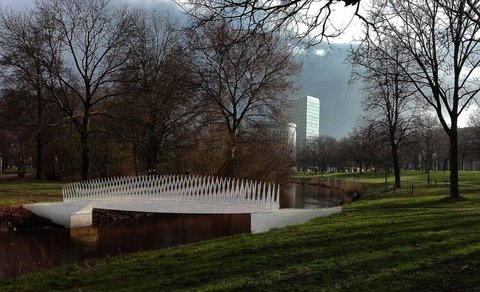As of Thursday, the general public will be able to use the world’s first fully biocomposite footbridge on the Eindhoven University of Technology campus. This fourteen meter long ‘biobridge’ is made from a hemp and flax-fiber base and is the result of collaboration between a large number of knowledge institutions and companies. The Eindhoven city councilor Mary-Ann Schreurs will perform the official public opening ceremony on Thursday 27 October at 4.15 pm.

Students from TU/e, TU Delft and the Eindhoven region’s vocational colleges, among others, have been building the bridge over recent weeks. Tuesday afternoon 25 October the bridge will be placed across the stream the Dommel, on the TU/e campus by the Auditorium. Fibers of hemp and flax are the basic material of the bridge. In order to develop the biocomposite, the fibers were stuck to a biological PLA foam (polylactic acid) core and then a bioresin was sucked into the fiber layers using a vacuum, which produced a very strong girder when hardened.
Sensors
Last Friday the bridge load capacity was successfully tested for the municipality of Eindhoven. The idea is that the ‘biobridge’ should remain for a year. Twenty-eight sensors in the bridge will measure the bending that occurs. “There have been previous construction projects with biomaterials, but never before were they bearing structures made entirely of biomaterials,” says TU/e researcher and project leader Rijk Blok. “Through this experiment we hope to learn a lot about the behavior of the biocomposite over the longer term.”
Goal
The initiators hope that this bridge will show the potential of biocomposite as a sustainable alternative for existing environmentally harmful construction materials. “Using biocomposite in constructions reduces our dependence on finite fossil resources and brings us a step closer to the circular economy in which products and resources are reused,” Blok says. “In time, I expect that we will see more of these materials in our buildings.”
Collaboration
The bridge is the result of the 4TU Lighthouse research project ‘B3: Fully Bio-Based composite pedestrian Bridge’. The partners were TU/e (chair Innovative Structural Design), TU Delft, composite company NPSP and the Center of Expertise Biobased Economy, a collaboration between Avans Hogeschool and HZ University of Applied Sciences. The project was co-funded by Stichting Innovatie Alliantie (SIA).
Source
Technische Universiteit Eindhoven, press release, 2016-10-24.
Supplier
Technische Universiteit Eindhoven
University of Technology, Delft (NL)
Share
Renewable Carbon News – Daily Newsletter
Subscribe to our daily email newsletter – the world's leading newsletter on renewable materials and chemicals












